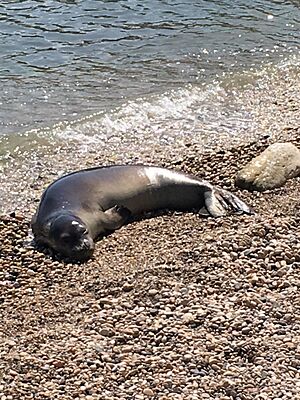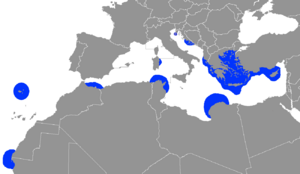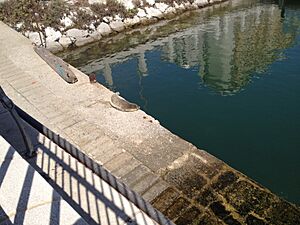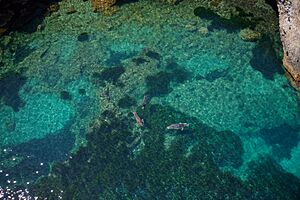Mediterranean monk seal facts for kids
Quick facts for kids Mediterranean monk seal |
|
|---|---|
 |
|
| Alonnisos Marine Park, Greece | |
| Conservation status | |
| Scientific classification | |
| Genus: |
Monachus
|
| Species: |
monachus
|
 |
|
The Mediterranean monk seal (Monachus monachus) is a special type of monk seal. It belongs to the Phocidae family, which are also known as "true seals." As of 2015, there were fewer than 700 of these seals left. They live in a few separate groups in the Mediterranean Sea, especially around the Aegean Sea. You can also find them near Madeira and the Cabo Blanco area in the Atlantic Ocean. Many people believe it is the rarest type of pinniped (a group of animals that includes seals, sea lions, and walruses) in the world. This seal is the only species in its group, called Monachus.
Contents
About the Mediterranean Monk Seal
What They Look Like
These seals are born about 80 centimetres (2.6 ft) long. As adults, they grow to an average of 2.4 metres (7.9 ft). Females are usually a little shorter than males. Males weigh about 320 kilograms (710 lb), and females weigh around 300 kilograms (660 lb). Their total weight can be anywhere from 240–400 kilograms (530–880 lb).
Monk seals are thought to live up to 45 years. However, most live for about 20 to 25 years. They can start having babies when they are about four years old.
Baby monk seals, called pups, are about 1 metre (3.3 ft) long. They weigh around 15–18 kilograms (33–40 lb). Their skin is covered in dark brown or black hair, about 1 to 1.5 centimeters long. They have a white stripe on their bellies. This stripe looks different for males and females. In females, it's usually shaped like a rectangle. In males, it's often shaped like a butterfly. This baby hair falls off after six to eight weeks. It is replaced by the short hair that adult seals have. Adult seals also shed their fur once a year. This makes their color change throughout the year.
Mediterranean monk seals have very short fur, shorter than any other pinniped. Males are black, while females are brown to dark grey. Their bellies are lighter, almost white in males. Their snout is short, wide, and flat. They have long nostrils that point upwards. This is different from their Hawaiian relatives, whose nostrils face more forward. Their flippers are quite short and have small, thin claws. Monk seals also have two pairs of nipples on their belly, which can be pulled back into their body. Most other seals do not have this.
How They Reproduce
We don't know a lot about how these seals have babies. As of 2020, scientists think there are about 500 pairs of monk seals left in the world. It's believed that one male seal mates with several females. Males are very protective of their mating areas.
Monk seals can have babies all year round. However, most births happen in September, October, and November. Mating happens in the water. But females give birth and care for their pups on beaches or in underwater caves. They might use underwater caves to keep their babies safe from predators. Mothers use their stored fat to feed their pups.
Sadly, only about 29% of pups born between September and January survive. One reason for this low survival rate is the high waves that happen during these months. These waves can be dangerous for young pups. Pups born in other months have a much better survival rate, around 71%. Because there are so few seals, there's also a risk of inbreeding and less genetic variety.
In 2008, a mother seal was seen feeding her pup on an open beach. This was the first time this had been seen since 1945. It might mean that seals in Cabo Blanco are starting to feel safe enough to use open beaches for breeding again.
Pups first go into the water about two weeks after they are born. They stop drinking their mother's milk around 18 weeks old. Mothers caring for pups will go to find food for about nine hours at a time. Most female seals can start having babies when they are four years old. Males start breeding at age six. Pregnancy lasts for almost a year. However, in the Cabo Blanco group, it's thought that pregnancy can last a little longer than a year.
What They Eat
Mediterranean monk seals are active during the day. They eat many kinds of fish and mollusks. Their favorite foods are octopus, squid, and eels. They can eat up to 3 kilograms (about 6.6 pounds) of food each day.
They usually hunt in shallow waters near the coast. But they can also dive deep, up to 250 meters (about 820 feet), to find food. Monk seals like to hunt in wide-open areas. This allows them to use their speed to catch prey. They are good at finding food on the ocean floor. Some have even been seen lifting rocks to look for hidden prey.
Where They Live
The places where these seals live have changed a lot over time. Long ago, and even up to the 1900s, Mediterranean monk seals would gather, give birth, and rest on open beaches. But more recently, they have moved away from these areas. Now, they only use sea caves for these activities. These caves are often hard for humans to reach. Many caves have underwater entrances and are found along remote or rocky coastlines.
Scientists believe this change happened recently. It's probably because of the fast growth of human populations, tourism, and industries. These things have caused more disturbances for the seals and destroyed their natural homes. Monk seals are shy and don't like being around humans. So, they have slowly learned to avoid people completely over the last century, or even earlier. However, these coastal caves can be dangerous for newborn pups. Many pups die when sea storms hit the caves.
Where They Are Found and Their Status
The Mediterranean monk seal lives in the Mediterranean Sea near Croatia, Cyprus, Greece, and Turkey. They are also found in the North Atlantic Ocean near Mauritania and Western Sahara. They might have disappeared from places like Albania, Corsica, Egypt, France, Italy, Libya, Malta, Monaco, Montenegro, southern Spain (and the Balearic Islands), and Tunisia. We don't know their status in Algeria, Israel, Lebanon, Morocco, and Syria.
Historically, these earless seals lived all the way from the northern Atlantic coast of West Africa to the Black Sea. This included all islands in the Mediterranean, the Canary Islands, Madeira, Desertas, Porto Santo, and even as far west as the Azores. Some seals would travel as far south as The Gambia and the Cape Verde islands. They could also be found as far north as Portugal, Northern Spain, the Bay of Biscay, and the coast of Brittany.
Several things caused their numbers to drop greatly over time. In the past, people hunted them for commercial reasons, especially during the Roman Empire and Middle Ages. In the 20th century, fishermen often killed them. Fishermen saw them as pests because the seals would damage fishing nets while trying to eat the fish caught in them. Also, cities growing along the coast and pollution have harmed their homes.
Some seals have survived in the Sea of Marmara. But the last time a seal was reported in the Black Sea was in 1997. Monk seals lived on Snake Island until the 1950s. Places like the Danube Plavni Nature Reserve and Doğankent were the last known places where they would rest on land after 1990.
Today, the total number of Mediterranean monk seals is estimated to be less than 700. They are spread out over a very large area. This makes them an endangered species. Their small and scattered population is a big threat to them. There are only two main places where their populations are considered strong enough to survive. One is the Aegean Sea (with 250–300 animals in Greece, especially around Gyaros island, and about 100 in Turkey). The other important group is in the Atlantic Ocean, in the Western Saharan part of Cabo Blanco (around 270 seals). This group might help the small but growing group in the Desertas Islands (about 30-40 seals). There might also be some seals using coastal areas in other parts of Western Sahara, like Cintra Bay.
These two main groups are very far apart. This means seals cannot easily travel between them to mix populations. All other remaining groups have fewer than 50 adult seals. Many are just very small groups, often with fewer than five seals.
Other small groups are found in southwestern Turkey and the Ionian Sea (both in the eastern Mediterranean). The species is almost gone in the western Mediterranean. There are still tiny groups in Morocco and Algeria. Sometimes, seals are seen traveling to places like the Balearic Islands, Sardinia, and other western Mediterranean spots, including Gibraltar.
In Sardinia, a Mediterranean monk seal was last seen in May 2007 and April 2010. More sightings in Sardinia suggest that the seal sometimes lives along the Central Eastern Sardinian coasts. These areas have been protected since 1998 by the National Park of Golfo of Orosei.
Groups of seals on the Pelagie Islands (Linosa and Lampedusa) were harmed by fishermen. This likely caused them to disappear from those areas.
Cabo Blanco Recovery
Cabo Blanco, in the Atlantic Ocean, has the largest single group of these seals that is still surviving. It's also the only place that still seems to have a colony structure. In the summer of 1997, more than 200 seals, or two-thirds of the population there, died within two months. This put the species at great risk. Scientists are still debating the exact cause. It might have been a virus or, more likely, a harmful algae bloom. This mass die-off showed how fragile the species was, as it was already considered critically endangered.
Since then, the numbers in this important location have slowly started to recover. A small group (up to 20 seals by 2009) in the area began using open beaches again. In 2009, for the first time in hundreds of years, a female seal gave birth to her pup on the beach. Open beaches are the best place for pups to survive. However, seals had stopped using them because of human activity and hunting in past centuries.
By 2016, the colony had grown back to its previous size of about 300 animals. This was possible thanks to a recovery plan funded by Spain. Also in 2016, a new record was set for births in the colony, with 83 pups born.
However, there is still a risk that a similar event could happen again. This could greatly reduce or even wipe out the entire population.
Recent Sightings


In June 2009, a monk seal was seen off the island of Giglio, in Italy.
On January 7, 2010, fishermen saw an injured Mediterranean monk seal off the coast of Tel Aviv, Israel. When experts arrived to help, the seal had gone back into the water. Members of the Israel Marine Mammal Research and Assistance Center tried to find it but could not. This was the first time this species had been seen in the area in 70 years. The seal was also seen a few weeks later in Rosh Hanikra.
In April 2010, a seal was reported near the island of Marettimo, in the Egadi Islands off the coast of Italy. In November 2010, a Mediterranean monk seal, thought to be 10 to 20 years old, was seen in Bodrum, Turkey. On December 31, 2010, news reported that the MOM Hellenic Society had found a new group of seals on a remote beach in the Aegean Sea. The exact spot was kept secret to protect the seals. The society asked the Greek government to make that part of the island a marine protected area.
On March 8, 2011, news reported that a baby seal had been seen on February 7 while monitoring a seal group in the southwestern Aegean Sea. The pup seemed weak and was taken to a rescue center. The goal was to release it back into the wild when it was strong enough. In April 2011, a monk seal was seen near the Egyptian coast after being absent from the country for a long time.
On June 24, 2011, the Blue World Institute of Croatia filmed an adult female underwater in the northern Adriatic, near the island of Cres. Another seal was seen on June 29, 2012. On May 2, 2013, a seal was seen at the southernmost tip of the Istrian peninsula near Pula. On September 9, 2013, in Pula, a male seal swam to a busy beach. It entertained many tourists for five minutes before swimming back to the sea. In summer 2014, seals were seen almost daily in Pula. A monk seal even stayed on crowded city beaches many times, sleeping calmly just a few meters from people. To keep both seals and people safe, the local city council put up special educational signs on city beaches. Despite clear instructions, a tourist bothered a seal. The event was filmed. Less than a month later, on August 25, 2014, this female monk seal was found dead near Šišan, Croatia. Experts said she died naturally due to old age.
In 2012, a Mediterranean monk seal was seen in Gibraltar at a private boat club.
In April 2013, what was believed to be a monk seal was seen in Tyre, southern Lebanon. Photographs were shared by local media. A study by the Italian Ministry of the Environment in 2013 confirmed that monk seals were present in a marine protected area in the Egadi Islands. In September and October 2013, an adult pair was seen many times in waters around RAF Akrotiri in Cyprus.
In November 2014, an adult monk seal was reportedly seen inside the port of Limassol, Cyprus. A female monk seal, named Argyro by locals, was seen often on beaches of Samos island in 2014 and 2015. Two seals were reported in April 2016.
On April 7, 2015, a large floating "fish" was reported near Raouche, Beirut in Lebanon. It was collected by a local fisherman. This turned out to be the body of a female monk seal that had lived there for some time. Further checks showed she was pregnant with a pup.
On August 13, 2015, ten monk seals were seen in Governor's Beach, Limassol, Cyprus.
On January 6, 2016, a monk seal climbed onto a parked boat in Kuşadası.
On April 10, 2016, a monk seal was seen and photographed by students and scientists in a creek in Manavgat District in Turkey's southern Antalya Province. Scientists said this was the first time a monk seal had been seen swimming in a river. Possible reasons included better hunting or higher salt levels in the water.
On April 26, 2016, two monk seals were seen at the municipal baths area of Paphos, Cyprus.
On October 18, 2016, a monk seal was filmed near Gulf of Kuşadası.
On November 3, 2016, a monk seal was seen at the coast of Gialousa in Cyprus.
On June 13, 2017, a seal was seen and photographed by fishermen off the coast of Tricase in southern Italy.
In early 2018, a mother seal and her pup were seen near Paphos Harbour in Cyprus.
In November 2018, a young monk seal was seen at the coast of Karavostasi in Cyprus. Sadly, it was found dead in the same area a few days later.
On March 15, 2019, a monk seal was seen and photographed at a marina in Kuşadası.
On July 20, 2019, a monk seal was seen in Protaras bay area in Cyprus.
On January 27, 2020, a young monk seal was found dead in Torre San Gennaro in Apulia, Italy.
On December 15, 2020, a monk seal was seen and filmed sitting on a sunlounger in Samos Island, Greece.
On July 24, 2021, a rescued and rehabilitated monk seal named "Kostis" was found dead. MOm, a Greek society for monk seal protection, reported that the seal had been killed. MOm offered a reward for information leading to the arrest of those responsible.
On April 24, 2023, a large monk seal was seen at Korakonisi, Zakynthos in Greece. It stayed on the surface for about a minute, watching people, then dived and was not seen again that day.
On May 12, 2023, a healthy adult female monk seal was seen resting for several hours on a beach in Jaffa near Tel Aviv, Israel. Israel's Nature and Park Authority has been watching this seal, named "Yulia." She is estimated to be twenty years old. Researchers have seen her in Turkey and Lebanon, where she is known as "Tugra." Experts believe she is shedding her winter fur. She mostly relaxes in a fenced-off part of the beach and sometimes goes into the water.
Protecting the Mediterranean Monk Seal
Sometimes, Mediterranean monk seals damage fishermen's nets or attack fish farms in Turkey and Greece. This has led some local people to hunt them, often out of anger. However, many groups, foundations, and universities have been working to protect these seals since the 1970s. For the past 10 years, many groups have taught local people how to prevent damage and protect the seals. There are good reports about these efforts helping the seals.
In the Aegean Sea, Greece has set aside a large area to protect the Mediterranean monk seal and its home. The Greek Alonissos Marine Park, around the Northern Sporades islands, is where the Greek MOm organization does most of its work. MOm helps to make people aware of the seals' situation. They also raise money to help protect monk seals in Greece and wherever else they are needed. Greece is also looking into making another seal breeding site a national park. Some sites are also part of the NATURA 2000 protection plan. Laws in Greece are very strict about hunting seals. Generally, people in Greece are very supportive of efforts to protect the Mediterranean monk seal.
One of the largest groups working to protect the Mediterranean monk seal is the Mediterranean Seal Research Group (Turkish: Akdeniz Foklarını Araştırma Grubu). This group works under the Underwater Research Foundation (Turkish: Sualtı Araştırmaları Derneği) in Turkey, also known as SAD-AFAG. This group has worked with officials in Foça on protection efforts. They also have hotlines for people to report seal sightings.
Protecting the species means protecting both land and sea. This is because the seals need places on land to rest and caves or caverns to rest and have babies. Even though responsible scuba diving instructors avoid trips to known seal caves, news of a seal sighting quickly attracts tourists. Irresponsible scuba diving trips can scare seals away from caves that could be their homes.
The Environment and Urbanization Minister of Turkey announced on November 18, 2019, a plan to further protect the species. This plan aims to help the groups of seals in Foça, Gökova, Datça, and Bozburun grow in number.
Conservation Efforts
Under the Convention on Migratory Species of Wild Animals (CMS), also known as the Bonn Convention, a special agreement was made. It's called the Memorandum of Understanding (MoU) concerning Conservation Measures for the Eastern Atlantic Populations of the Mediterranean Monk Seal. This agreement started on October 18, 2007. The MoU covers four countries: Mauritania, Morocco, Portugal, and Spain. All of them have signed it. The goal is to create a legal framework to carry out the Action Plan for the Recovery of the Mediterranean Monk Seal in the Eastern Atlantic.
Because there are signs that some seal groups are slowly growing, the Mediterranean monk seal's IUCN conservation status was changed in 2015. It moved from critically endangered to just endangered. This change was made based on how fast their numbers were declining.
Monk Seals in Old Stories
The Mediterranean monk seal sometimes appears in old stories and myths. In Homer's The Odyssey, the sea god Proteus is shown guiding monk seals for Poseidon. A mythical hero named Phocus of Aegina was the son of the nereid Psamathe. He was born when she had changed into a seal. The ancient city of Phocis (and maybe Phocaea) was named after Phocus. The city of Phocaea even used the monk seal as its symbol. This might be because of the myth of Phocus' birth. Or it could be because monk seals used to live where Phocaea was built. There is only one known old drawing of a monk seal from ancient times. It is on a pot called a Caeretan hydria, likely made by people from Phocaea who had moved to Etruria.
Even with these connections to myths, people in ancient Greece and Rome often disliked and feared the monk seal. This was because of how it looked, its smell, and its connection to the unknown ocean. Many Greek and Roman sayings showed the seal in a bad way. This dislike might have helped cause their numbers to drop over a long time.
In the 11th century BC, the Assyrian king Tiglath-Pileser I received several animals as gifts from the Egyptian pharaoh Ramesses XI. These included a crocodile and a mysterious creature called the "river-man." These animals were shown in the zoo of his son Ashur-bel-kala. They are drawn on several pieces of Ashur's monuments. A pair of back flippers on one piece has been identified as belonging to the "river-man." If this is true, it means the "river man" was almost certainly a monk seal.
Images for kids
See also
- Hawaiian Monk Seal
- Mediterranean Monk Seal Memorandum of Understanding








